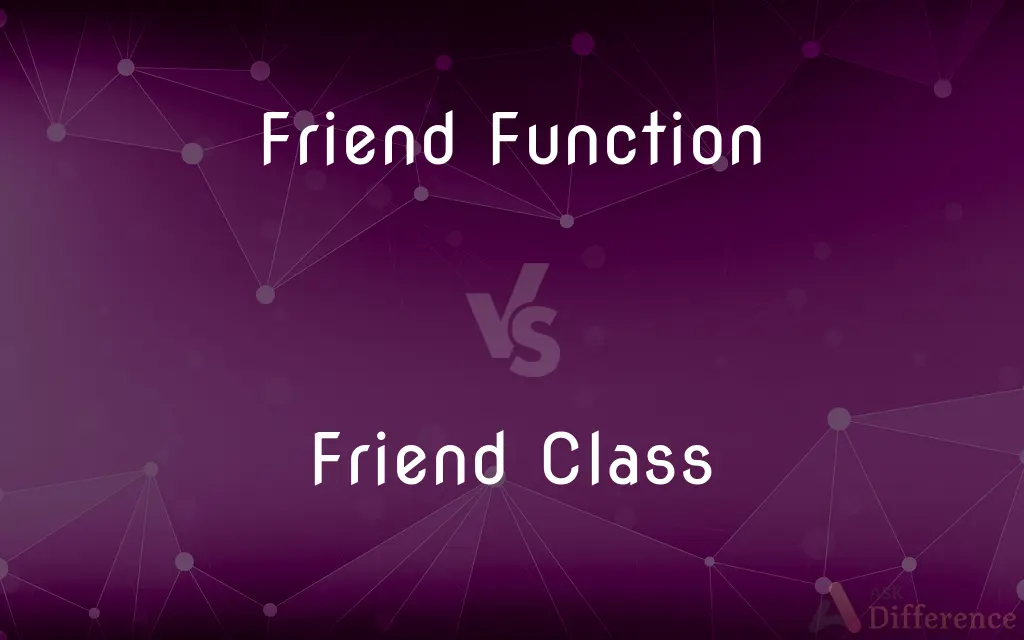Friend Function vs. Friend Class — What's the Difference?
By Tayyaba Rehman & Fiza Rafique — Published on February 7, 2024
A Friend Function is a function that is given access to the private and protected members of a class, while a Friend Class is a class whose members have access to the private and protected members of another class.

Difference Between Friend Function and Friend Class
Table of Contents
ADVERTISEMENT
Key Differences
A Friend Function in C++ is a function declared with the friend keyword, allowing it access to the private and protected members of a class. A Friend Class, on the other hand, is a class whose all member functions are declared as friends to another class, granting them similar access privileges. While a Friend Function is an individual function given access to another class, a Friend Class involves an entire class receiving such access.
Friend Functions are not members of the class to which they have access but can operate on private data within that class. Conversely, when a class is declared as a Friend Class, all of its member functions can access the private and protected data of the class it befriends. This distinction underlines a Friend Function as a standalone entity, whereas a Friend Class extends this privilege to multiple functions within a class.
In implementing Friend Functions, a specific function is chosen for accessing critical data, limiting the scope of access. For Friend Classes, the scope is broader, as all member functions of the declared friend can access the sensitive data, increasing the potential for data exposure. Therefore, Friend Functions offer a more granular level of access control compared to Friend Classes.
The declaration of a Friend Function is done within the class it needs to access, but it remains external to all classes. In contrast, a Friend Class is declared as a friend in the class whose members it needs to access, signifying a closer relationship. This difference highlights the Friend Function as an external helper, while a Friend Class is more like an allied class with broader access.
Friend Functions are typically used when only a few external functions require access to the private parts of a class, maintaining tighter encapsulation. Friend Classes are employed when an entire class needs to closely cooperate with another class, often used in complex systems where classes are interdependent. The use of Friend Functions and Friend Classes thus depends on the required level of access and the design architecture of the software.
ADVERTISEMENT
Comparison Chart
Definition
A function given special access to another class's private and protected members.
An entire class given access to another class's private and protected members.
Scope of Access
Specific functions get access.
All member functions of the class get access.
Usage
Used for individual functions needing access to another class's internals.
Used when one class needs extensive access to another class.
Type of Relationship
Function-to-class relationship.
Class-to-class relationship.
Declaration
Declared within a class using the friend keyword.
An entire class is declared as a friend inside another class.
Compare with Definitions
Friend Function
A non-member that can access class's restricted sections.
For complex mathematical operations, a standalone friend function was granted access to the class's internals.
Friend Class
Allows all members of one class to access another’s private sections.
The TestSuite class was declared as a friend class to access and test the private methods of the System class.
Friend Function
Not a class member but can access protected data.
The friend function can modify the protected attributes of our class despite not being a member.
Friend Class
A class with access to another class’s private data.
In our application, the Renderer class is a friend class to the Window class, accessing its private properties.
Friend Function
Enables external function access to class internals.
We used a friend function for efficient data manipulation within the class.
Friend Class
Establishes a class-to-class intimate access relationship.
For better integration, the Database class is a friend class of the Authentication class.
Friend Function
Allows non-member functions to access private and protected members.
The external logging function was made a friend function to access class's private state for debugging.
Friend Class
Grants a class extensive access to another’s internals.
The friend class Analytics has comprehensive access to the private data of the User class.
Friend Function
A function with access to a class's private members.
In C++, we declared a global function as a friend function to access the private data of a class.
Friend Class
Entire class accessing another class’s protected members.
We made the Controller class a friend class of the Model class for direct data manipulation.
Common Curiosities
Can a friend function be a member of another class?
Yes, a friend function can be a member of another class, but it is not a member of the class in which it is declared as a friend.
What is a friend function in C++?
A friend function in C++ is a function that has access to the private and protected members of the class in which it is declared as a friend.
Can a friend function access all private members of a class?
Yes, a friend function can access all private and protected members of the class in which it is declared as a friend.
How do you declare a friend class in C++?
A friend class is declared by using the friend keyword followed by the class name inside the class whose members it needs to access.
Does declaring a friend class increase compilation dependencies?
Yes, declaring a friend class can increase compilation dependencies due to the tight coupling between classes.
How is a friend class used in programming?
A friend class is used to allow one class to access the private and protected members of another class, facilitating closer integration between classes.
Are friend functions part of the class?
Friend functions are not part of the class; they are external functions granted special access privileges.
Does a friend class violate encapsulation?
While a friend class does access private data of another class, it is typically used judiciously and doesn’t necessarily violate encapsulation principles.
What is the primary purpose of using friend classes?
The primary purpose of using friend classes is to allow tight coupling between classes where direct access to private members is necessary for functionality.
Is it possible to have multiple friend functions for a class?
Yes, a class can have multiple friend functions, each declared with the friend keyword.
How does a friend function differ from regular member functions?
A friend function differs from regular member functions as it is not a member of the class but can access the class's private and protected data.
Is it a good practice to frequently use friend functions and classes?
While friend functions and classes are useful, they should be used sparingly to maintain the integrity of object-oriented principles.
Can a friend class have its own private members?
Yes, a friend class can have its own private members, independent of the class it is a friend to.
Are friend classes commonly used in object-oriented programming?
Friend classes are used in object-oriented programming but are generally less common due to their specific use-case scenarios.
Can constructors or destructors be friend functions?
Yes, constructors and destructors can be declared as friend functions if needed.
Share Your Discovery

Previous Comparison
Dilution vs. Dilution Factor
Next Comparison
Foolscap Paper Size vs. Legal Paper SizeAuthor Spotlight
Written by
Tayyaba RehmanTayyaba Rehman is a distinguished writer, currently serving as a primary contributor to askdifference.com. As a researcher in semantics and etymology, Tayyaba's passion for the complexity of languages and their distinctions has found a perfect home on the platform. Tayyaba delves into the intricacies of language, distinguishing between commonly confused words and phrases, thereby providing clarity for readers worldwide.
Co-written by
Fiza RafiqueFiza Rafique is a skilled content writer at AskDifference.com, where she meticulously refines and enhances written pieces. Drawing from her vast editorial expertise, Fiza ensures clarity, accuracy, and precision in every article. Passionate about language, she continually seeks to elevate the quality of content for readers worldwide.
















































